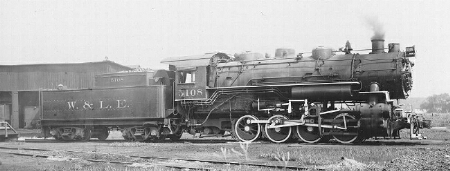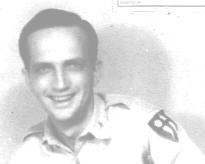|
|
Richard tells me that he first saw the light of day at Stillwater, Ohio in
1919. Ohio elementary schools put up with him
until he was eleven years old. At this stage of his life, Dick became familiar with locomotives such as the monster depicted below. His father was a telegrapher on the Wheeling & Lake Erie Railroad and, during periodic visits with his dad at the Dillonvale, Ohio railroad yards, giant engines, similiar to that shown, would regularly rumble by shaking the rickety railroad administrative building.

After completing sixth grade, Dick scooted off to
Pennsylvania where he finished grammar school in Youngstown and high school in
Latrobe (You know, the home of Arnold Palmer and Rolling Rock beer).
After high school, he soon came to appreciate the true significance of the Great
Depression when there were no decent paying jobs available to
inexperienced grads.
Realizing that the $21 per month, plus room and board, offered
by the army was a slight improvement over what was available at home, Richard
signed up for a two year "hitch" in 1939.
His first assignment was to the Panama Canal Zone where he spent two years learning the ropes. Dick had originally joined the Service with
the idea that he would return to his native haunts (and girl friends) after a relatively short absence.
This was not to be as, by the time he returned to the US from Panama, Hitler was acting up
in Europe and a military draft was in effect at home.
He finally decided to take the
army seriously and subsequently qualified as a 2nd Lieutenant, Signal Corps in August, 1942. During
WWII, Dick served in the China-Burma-India Theater of Operations (CBI).
A photo, as snapped of him while in the CBI, is shown at the bottom of this page.
Following the war, he decided to remain in the Service, at least for a while
longer. Dick then spent about a year and a half serving in Separation Centers located at Indiantown Gap, PA. and Fort Dix, N.J. Italy was the next overseas destination. In this instance, he was fortunate in that he had the opportunity to serve the entire year of
1947 with the Rome Area Allied Command in Rome. Service with the U.S. Constabulary in Germany was in store for him following the tour
in Italy. Upon returning to the U.S. from Germany, Dick labored as a staff officer in The Signal School at Fort Monmouth, NJ
until ordered to participate in the Korean "Police Action" in
1952. After finishing duties with the Signal Section, Headquarters, Eighth Army in Korea, he spent 2 additional years with Headquarters, Army Forces, Far East in
Japan; again returning to Fort Monmouth in 1956.
After duty with the Signal Corps Board at Fort Monmouth, the
next assignment was to Hq, U.S. Army Hawaii/25th Infantry Division for three more years. Then our subject spent 3 years with the Office of the Chief, Communications-Electronics in the Pentagon. This was followed by a tour in Vietnam where he
was employed as an advisor to the J6 (Communications-Electronics) of the
Vietnamese Joint High Command. After finishing there, he went
directly to Germany for a second tour in that country; on this occasion, Richard served as Chief, Operations Branch, Tactical Communications Division, Signal Section, Hq U.S. Army Europe. Finally, he retired in 1969.
After retirement and settling in Florida, Dick arranged for the education he admits he should have acquired 30 years or so
earlier. Our subject attended Rollins College and was awarded a dual Bachelors Degree plus a Masters Degree in Education. Unfortunately, a promising career as a high school teacher was cut short when a hearing impairment suffered near the end of his army career became considerably worse and it was no longer feasible for him
to teach.
Along the way, Dick has been blessed by the company of two beautiful and loving wives (his first wife died in 1957).
His current activities include Amateur Radio (W4YWA), gardening, net
surfing, and pet maintenance. Oreo, the current head cat, approves of that.



|

